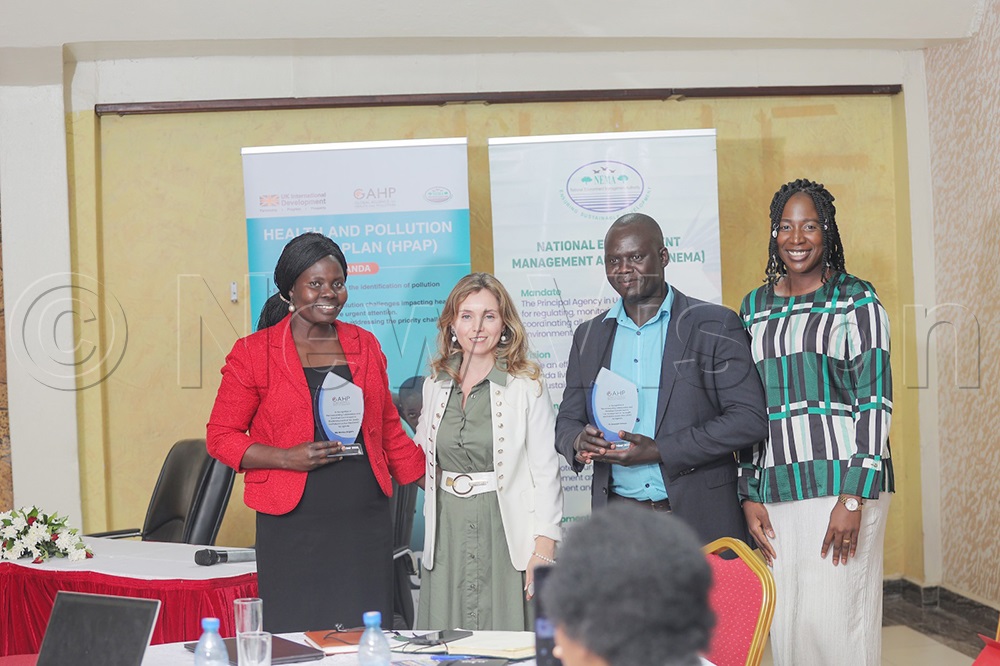Highly polluted areas in Kampala named
The communication and Engagement Lead at AirQo Project, Makerere University, Adrine Priscah said these trends underscore the health risks to vulnerable populations and the economic burden from lost productivity and healthcare costs.
Officials from Makerere University NEMA and GAPH pose for a group photo during the inception meeting. (Credit: Agnes Kyotalengerire)
__________________
Kampala is grappling with high levels of air pollution, causing persistent health complications and even death, a new report has revealed.
Findings from the 2025Air Quality analysis reveal that between January to September 2025, Central Kampala registered high levels of air pollution with particulate matter (smallest dust particles) of size 2.5 concentration, averaging at 33.90 μg/micrograms per cubic meter (μg/m3).
This is against the recommended 5μg/m3 as per the annual World Health Organisation Air Quality Guidelines (AQG) 2021 and National Environmental Management Authority (NEMA 25 µg/m³ annual) guidelines.
Although this is moderate air quality, it is a slight drop from the average concentration 40 μg/m3 in 2024, which was unhealthy for sensitive groups.
Notably, Kawempe, Nakawa and Makindye divisions recorded the highest levels of air pollution, and this was during rush hours (8:00am and 7:00pm).
Breaking it down, in Kampala central division, higher pollution values were found in the Nakasero, Kamwokya, and Kisenyi areas.
In Kawempe Division, areas of Kalerwe and Kawempe had the highest pollution levels.
While in Nakawa division, the highest polluted areas were Naguru and Kyanja.
For the Makindye division, higher pollution values were discovered in the Katwe, Luwafu, Kabalagala, and Kansanga areas.
The communication and Engagement Lead at AirQo Project, Makerere University, Adrine Priscah said these trends underscore the health risks to vulnerable populations and the economic burden from lost productivity and healthcare costs.
Findings from Trends of PM2.5 concentrations in Kampala for the last 50 days (3/08/2025 -21/09/2025) showed that the fine dust particulate levels (PM2.5 concentrations) were found to be higher than the World Health Organisation (WHO) recommended permissible limit of 24-hour guideline of 15 µg/m³.
The communication and Engagement Lead at AirQo Project Makerere University, Adrine Priscah.
The minimum and Maximum PM2.5 concentrations of fine dust particles for the same period fell between 21.1 µg/m³ and 80.3 µg/m³, respectively.
The study was conducted by the Eastern Africa GEOHealth Hub at Makerere University School of Public Health.

The executive director, GAPH Maria Paola, handing over an accolade to Innocent Achaye from NEMA during the inception meeting. (Credit: Agnes Kyotalengerire)

The executive director, GAPH Maria Paola, posing for a photo with officials from NEMA after receiving recognition awards. (Credit: Agnes Kyotalengerire)
Peak zones
The Co-Investigator and Technical Administrator, Eastern Africa GEOHealth Hub at Makerere University School of Public Health, Eng. Samuel Etajak said that, particularly, air pollution is very high between 8:00am and 10:00am because of heavy traffic. It again peaks between 3:00pm to 10:00pm because there is a lot of traffic when people are driving back home. Air pollution was also high during dry months.
Air pollution mortality
A study conducted in Kampala between a period of four years (2018 to 2021) revealed that up to about 7,000 deaths were attributable to air pollution.
The first mortality study that was conducted by the Eastern Africa GEOHealth Hub at Makerere University School of Public Health analysed hospital data for patients who succumbed to heart and lung conditions, as well as data from different air quality monitoring stations.
The state of global Air 2024 report indicates that air pollution was the second largest risk factor for death in 2021. In the same year, a total of 8.1 million people succumbed to air pollution. Of the deaths, 58% resulted from ambient particulate matter –PM 2.5, meanwhile 38% of the deaths resulted from household air pollution, and 6% of deaths were from ozone.
Worth noting, data by World Health Organisation (WHO) reveals that a total of 70009 children die due to air pollution globally every year.
The shocking data was released during the Health and Pollution Action Plan (HPAP) inception meeting at Hotel African on Thursday.
In attendance were officials from GAHP, NEMA and many other stakeholders, including the Minister of Health, UNDP, the Ministry of Gender, Labour and Social Development.
Sources of air pollution
The same report discovered that all the small particles causing air pollution in Kampala are coming from emissions from vehicle engines, construction sites, sweeping along roads and burning of polythene bags and plastic bottles.
Traffic emissions are the leading source, considering that the growth of urban populations has increased the number of vehicles in the country from about 490,000 vehicles in 2015 to over 2.4 million vehicles in 2023.
Indoor air pollution has been fueled by heavy reliance on solid biomass for cooking using firewood and charcoal, which accounted for around 87% of the national total energy consumption in 2021.
Open burning of agricultural residues, burning of polythene bags and plastic bottles.
Industrial emissions that result from cement production, steel manufacturing, and brick-baking kilns are sources of air pollutants such as SO₂, VOCs, and PM. Yet, many industries lack efficient emission control technologies, thereby releasing large amounts of pollutants
Interventions
Against this background, National Environment Management Authority (NEMA) in collaboration with Global Alliance on Health and Pollution (GAHP) with financial support from UKAID and Department for Environment Food and Rural Affairs (DEFRA), have embarked on developing the Health and Pollution Action Plan to help government prioritize its pollution agenda, define and advance concrete actions to reduce exposure to pollution and its related health impacts.
The executive director of GAPH, Maria Paola, noted that although Uganda is heavily affected by different types of pollution, there is a strong political commitment. In this regard, the alliance has partnered with NEMA since 2023 to address different pollution sources, Paola said.
Why you should care
Effects of exposure to air pollution
A senior lecturer at Makerere University, Dr Emmanuel Tebandeke, said when dust levels go higher than expected, they become harmful to vulnerable people such as the elderly, pregnant women, children and individuals battling against heart and lung diseases.
The worrying bit is that people with chronic illnesses, for example, Asthma, lung and heart diseases, end up suffocating or getting attacks, said Dr Tebandeke, who also heads the Chemistry department at Makerere University.
“If you have any of these health conditions, air pollution kills you faster,” he said
The Co-Investigator and Technical Administrator, Eastern Africa GEOHealth Hub at Makerere University School of Public Health, Eng. Samuel Etajak said exposure to high fine dust particles contributes to long- and short-term health effects.

Eng. Sam Etajak.
The short-term health effects include ear, nose and throat irritation, aggravated symptoms of allergies, asthma, bronchitis, Chronic obstructive pulmonary disease (COPD), trigger fast or irregular heartbeats and many more.
Long-term effects include heart diseases – high blood pressure, heart attacks, ischemic heart diseases, lung diseases – Lung cancer, infections, COPD, Asthma, Premature birth –or low birth weight, Stroke and Reduced life expectancy in a population, among others.
Explaining how stroke comes about, Etajak said the small dust particles can escape into your lungs through small parts called the alveoli, get into the blood system and end up in the brain.
In addition, the particles can also settle into the lungs, causing difficulty in breathing, respiratory diseases as well as cancer.
The state of global air 2024 report found that air pollution is responsible for 30% of deaths from lower respiratory infections, 28% of deaths from Ischemic heart diseases and 48% of deaths from chronic obstructive pulmonary diseases.
Interventions
To curb environmental pollution through exhaust emissions, in 2023, the government imposed a ban on the importation of cars older than 15 years, said the head of department compliance at the National Environmental Management Authority (NEMA), Leila Akello.
Kampala City Council Authority has embarked on sensitising the communities in Kampala and the Metropolitan area about air pollution.
Additionally, a total of 25 meters that measure the level of air pollution have been strategically areas in Kampala, including one at the NEMA offices, to monitor the air quality rates every day.
The effect of exposure to air pollution in children is reduced lung function as well as cognition. In order to monitor how much pollution children are exposed to while in school, Makerere School of Public Health plans to mount two modular sensors (QuantAQ MODULAIR-PM) in different divisions of Kampala.
In Kawempe division, the sensors will be set up in schools of St.Martin and St Paul Primary schools. For Nakawa division, they will be mounted in St James Biina, Luzira and St Jude Primary school in Naguru, and the same machines will be set up at Buganda Road Primary School and Kitante primary school in the central division.
What more need to be done
Etajak said there is a need to introduce speed limits as low as 30 kilometres per hour or less within the city centre to reduce emissions. “When you press your pedal harder, the engine emits a lot of particulate matter”, he said.
Additionally, there is need to plant more trees in the city and the surrounding suburbs to help trap the dust.